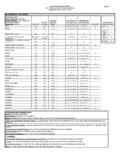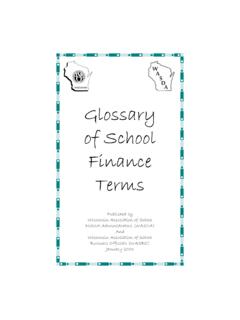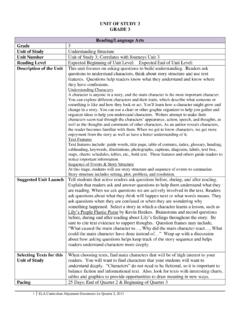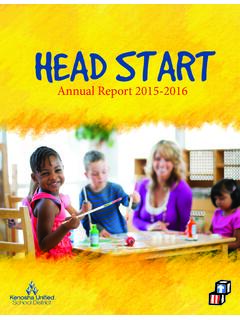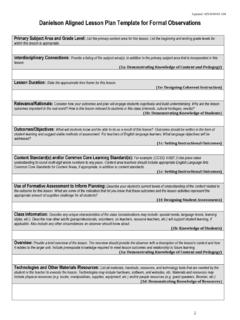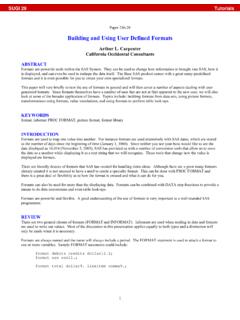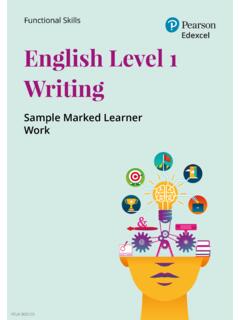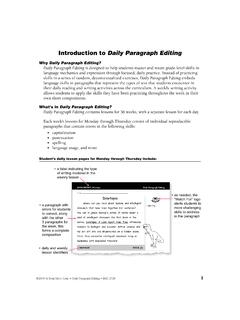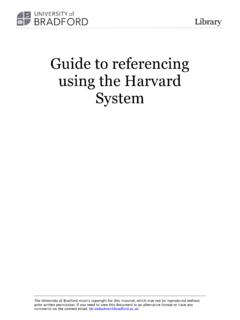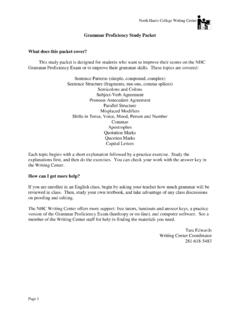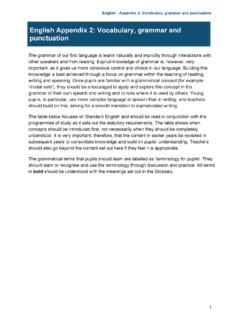Transcription of GRADE 5 RUBRIC FOR NARRATIVE WRITING
1 GRADE 5 RUBRIC FOR NARRATIVE WRITING 1 (1 Point) 2 (2 Points) 3 (3 Points) 4 (4 Points) STRUCTURE Overall The writer wrote about one time when he/she did something. The writer wrote about one time when he/she did something and told the story bit by bit. The writer wrote a story of an important moment. I read like a published story. The writer wrote a story that had tension, resolution, and realistic characters and conveyed an idea or lesson. Lead The writer thought about how to write a good beginning and chose a way to start the story. The writer chose action, talk, or setting to make the beginning.
2 The writer wrote a beginning that introduced the characters and setting of the story in an original way. The writer wrote a beginning that showed what was happening and where it happened. There were also clues to what would become the problem for the main character. The write wrote a beginning which set the plot or story in motion. It also hinted at the larger meaning of the story. Transitions The writer used words such as when, then, and after. The writer used words such as a little later or after that. The writer used transitional phrases to show time such as meanwhile, at the same time, early that morning, or three hours later.
3 The writer used transitional phrases to connect what happened to what happened ( , if he hadn t .. he might not have, because of, although, and little did she know that). Ending The writer chose the action, talk, or feeling that would make a good ending. The writer chose the action, talk, or feeling to end the story and worked hard at WRITING it. The writer wrote an ending that connected to the main part of the story. The character had a new realization. The writer created a sense of closure. The writer wrote an ending that connected to the meaning of the story. The writer created a sense of closure by showing a change in the character.
4 Organization The writer wrote a beginning, middle, and end of the story. Each part (beginning, middle, and end) of the story was many lines long. The writer used paragraphs to separate what happened first from what happened next, the events that took place later, or to show when a character was speaking. The writer used paragraphs to separate different parts or times of the story and to show when a new character was speaking. Some parts of the story were longer and more developed than others. The writer used paragraphs purposefully ( , to show time or setting changes or to create suspense of readers.)
5 1 (1 Point) 2 (2 Points) 3 (3 Points) 4 (4 Points) DEVELOPMENT Elaboration The writer described the characters using either talk or vivid action to make the characters come to life. The writer chose words carefully and worked hard to determine the right words and phrases to describe the characters, their actions, and their feelings. The writer developed characters, setting and plot throughout the story, especially the heart of the story. To do this the writer used a blend of description, action, dialogue, and thinking. The writer developed realistic characters and developed the details, action, dialogue, and internal thinking that contributed to the deeper meaning of the story.
6 Craft The writer chose strong words that helped the reader make a picture of the story in his/her mind. The writer included details about how the characters were thinking. The writer showed why the character did what he/she did. The writer made less important parts shorter and less detailed. The writer included precise details and used figurative language. The writer varied his sentences to create the pace and tone of the piece. The writer developed character traits and emotions through what characters said and did. The writer developed relationships between the characters.
7 The writer chose several key elements and stretched them out. The writer used precise descriptions, figurative language and symbolism. LANGUAGE CONVENTIONS Spelling The writer used spelling patterns some of the time. The writer used appropriate spelling patterns most of the time. The writer used spelling patterns correctly and edited regularly. The writer used spelling patterns correctly and extended them to create new words. Conventions The writer began and ended some sentences with capitalization and punctuation. The writer sometimes punctuated with commas and quotation marks.
8 The writer began and ended most sentences with capitalization and punctuation. The writer usually punctuated with commas and quotation marks. The writer edited independently. The writer used commas to set off introductory parts of sentences and used commas to show talking directly someone such as Are you mad, Mom? The writer used punctuation accurately to convey mood and build tension. Scoring Directions: In each row, highlight the descriptor in the column that matches the student s work. Scores in the categories of Elaboration and Craft are worth double the point value.
9 Total the number of points and then track students progress by seeing when the total points increase. Overall Score _____ Lead Score _____ Transition Score _____ Ending Score _____ Organization Score _____ Elaboration _____x 2 = _____ Craft Score _____x 2 = _____ Conventions Score _____ Spelling Score _____ Total Score: _____ Number of Points Scaled Score* 1 10 1 11 20 2 21 30 3 31 40 4 *The Scaled Score is recorded on the Class Report Form and the Consolidated Report Form.


